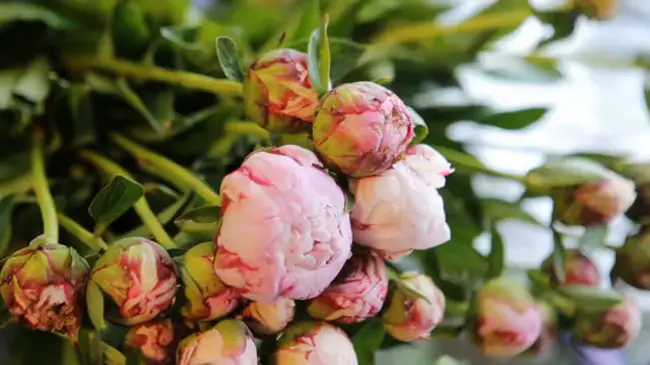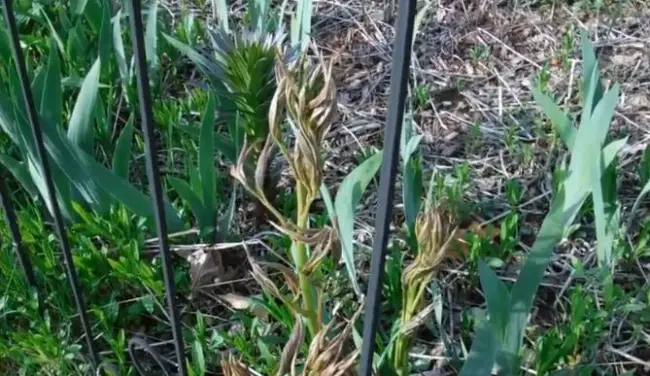Peonies are one of nature’s most stunning flowers and have been beloved for centuries by gardeners around the world. It is a showy and generally hearty perennial that doesn’t require much care. It has large, showy blossoms that come in soft rosy pink, deep red, and white.
Peonies are living plants, and like anything that lives, they are susceptible to infections and viruses. White mold, viruses, and wilt are common peony diseases. When planted properly and given proper growing conditions, the peony can be grown almost disease-free.
However, when the weather is wet, rainy, and humid for a period of time, the plants will suffer. Just like any organism, they can succumb to disease if not properly cared for. These are some ways to check for diseases if your peony plants are looking wilted or their growth seems to be stunted.
Whether you’re an experienced gardener or just getting started, having knowledge of potential risks is essential when it comes to caring for your prized peonies.
Peony’s Diseases
Like any flower, peonies can become diseased also. If planted in a site with insufficient sun, water drainage, and proper planting that includes spacing for air circulation and proper watering, they will become susceptible to disease.
Let’s take a look at different diseases that peonies might infect with.
Wilt
Peony wilt is a common and often devastating disease that affects peonies in gardens around the world. It’s easily recognizable by its wilting leaves, discolored stems, stunted growth, and eventual death of the plant. It’s important to take preventive measures to protect your plants from this heartbreaking condition.
You can check the base of your plant, and if the base looks good but the shoots are wilting, it may have what’s called Verticillium Albo-Atrum, a soil-born fungus and one that is almost impossible to get rid of.
What you need to do is to cut off a piece of the stem and check the cross-section to see if it is brown (it shouldn’t be). This is the plant’s self-watering system. If it is checked with your local county extension office (County Dept. of Forestry), you will want to ensure before removing and discarding your plants.
In order to prevent your peonies from wilt, you need to keep your garden clean and free of weeds or debris that could potentially spread infection. You should regularly inspect each plant for signs of wilting or discoloration so you can catch any potential issues early on before they become too severe. If you notice any signs of wilt on one of your plants, immediately remove it from the area as quickly as possible to prevent further spreading.
You need to always practice good gardening habits such as proper fertilization and irrigation techniques to create a healthy environment for your peonies. By taking precautionary steps like these, you can help ensure that your gorgeous blooms are safe from this dreaded disease. With just a few simple changes we can make a big difference in helping our beloved flowers thrive.
White Mold
The more common one you may expect to encounter, especially if the spring has been unusually cool and wet, is a fungus called Botrytis Blight, or White Mold (called Sclerotinia sclerotiorum).
White mold is a fluffy white mycelium that generally appears under humid conditions. It is a soil-inhabiting fungus that is impossible to remove, and your peony plants will need to be removed and replaced with nonsusceptible ones. Do not replant with peonies.
It is tough to stop this disease since it is a soil-borne fungus. Replacing and planting plants farther apart to allow for air circulation, and watering only at their bases at midday, will help reduce the infection.
Botrytis Blight symptoms include flower buds having brown spots, as well as the leaves, are having irregularly shaped spots. The flower buds or leaves of peonies tend to be covered with a wide area of gray fuzzy fungal spores. Botrytis will also show up when the weather has been cool, wet spring and summer.
The gray mold will cause unopened buds not to open and will spread quickly to open flowering buds. The infection will spread down the stems, causing a brown or tan discoloration. The infected petals will drop off into the leaves and cause the entire plant to become damaged.
This fungus will cause the stems to rot on not only your peonies but other herbaceous plants in your garden as well. White Mold will cause a portion or sometimes the entire plant to wilt. The infected part of the stem will become dry and stringy, and tan in color. If the weather conditions are humid, a fluffy white mold will appear.
To diagnose this, slice the stem lengthwise and check for signs of irregular sizes of hard black sclerotic inside the tan area of the stem. Sclerotinia is a soil-inhabiting fungus that is also nearly impossible to remove. Because it has an overwintering structure, it can last in the soil for years.
Virus Disease
Viruses are the most feared of all peony diseases. They spread quickly and can be very hard to eradicate once they become established in a plant population. Viral infections often cause severe leaf mottling, reduced flowering, stunted growth, and even death.
These viruses tend to show in the form of ring spots, mosaics, leaf curls, and or elongation. If your plant has a virus, the leaves will become light and dark green in color, stringy and curly. They will also have a reduction in growth and will be less vigorous.
They will, however, continue to grow and bloom as usual, except they will have a strange pattern on their leaves. No treatment is recommended for this, but if it becomes severe, remove and discard the plant.
There are fungicides available to treat wilt and white mold, but nothing will cure it. In the fall, cut back your peonies, and in early spring, when the red shoots first start to appear, start to treat the new shoots then. Treat the stems and buds at the beginning of the growing season to help prevent infestation.
The best defense against viruses is prevention – this means ensuring that your plants have good quality planting material free from virus contamination and avoiding contact with infected plants or tools. If you suspect a viral infection on any of your plants then it’s important to remove them immediately before they can infect other areas in your landscape.
In addition, proper cultural practices such as pruning out dead wood and removing old foliage can help reduce the risk of introducing a virus into your garden. Regular seasonal fertilizing also helps keep plants healthy and more resistant to disease-causing agents like viruses. With these steps, you can help ensure that your beautiful blooms stay vibrant for years to come!
By taking proactive measures we can lessen our chances of encountering peony viruses and increase our odds of enjoying their beauty season after season.
How To Prevent Peony’s Diseases
It is hard to stop the diseases after they appear. However, you can greatly reduce infections. The first step in prevention is proper planting, which includes selecting disease-resistant varieties of peonies and avoiding overcrowded plantings. Peonies need plenty of sun and good air circulation for optimal growth and flower production. When you water, be sure to avoid getting too much water on their leaves as this can encourage fungal diseases like powdery mildew.
It’s also important to monitor your garden regularly for signs of pests or diseases and take action immediately if any are found. This may involve removing diseased foliage, applying an appropriate pesticide or fungicide, or adjusting soil pH levels. Additionally, consider using organic mulches around the base of the plant to help conserve moisture while keeping weeds away from the root zone.
You should always practice good sanitation by disposing of fallen leaves, flowers, and stems that have been infected with a disease so they don’t spread further throughout your garden.
You need to do this after the morning dew has dried. This will prevent water from any wet plants from getting on healthy ones. When cutting off infected leaves and stems, clean your pruner with a 10% Bleach Solution or 70% Regular Rubbing Alcohol.
Always clean your tools before and after cutting off the diseased parts of any plant and before you prune the next one to prevent transfer. Carefully dispose of the infected parts, Do Not Place them in a Compost Bin or Pile. Good sanitation is important when your plants have been infected.
In the fall, you should cut back those diseased plants just below or to the ground. Then add some well-composted organic material as a mulch to the soil.
Fungicides have a limited effect against blights, but applying Copper Sulfate, when it’s applied early enough in spring when the shoots first emerge and reach about 6 inches tall, will protect them. Spray all the plant parts to wet the foliage and soil completely. Remember to read and follow the manufacturer’s instructions.
Prevent Powdery Mildew
We have issues sometimes where our peonies will get powdery mildew in terrible conditions. I have been trying an experiment now for putting cinnamon around the soil. For your information, fungus hates cinnamon, so it can help to repel the powdery mildew away.
You can get a bottle of cinnamon and shake it around the soil’s surface. Powdery mildew is growing so quickly, and you need to apply the cinnamon at the time before these diseases are attacking your peonies.
I normally apply this when the peonies are a lot smaller, but it won’t hurt them, and this should help ward off powdery mildew.
Prevent Ants and Wasps from Crawl To Other Plants
Another thing I wanted to talk about is why ants and wasps like to crawl on the peonies. The reason is the peony flowers need the wasps and ants to crawl across them to help open the flowers up. So that’s the reason why ants crawl on the peony buds when they get larger the peony flower needs them to open the flowers up.
However, if you see the ants crawling on your other plants, that can be a bad thing because they could be bringing aphids.
How To Treat Peony’S Diseases
When it comes to treating peony’s diseases, the most important thing is to identify the disease quickly. Early detection and treatment can prevent future problems from occurring. In some cases, an insect or fungus may be present that requires a different type of treatment than what would normally be used for prevention.
If your peonies show signs of infection or are wilting, you should remove any affected leaves and throw them away in order to stop the spread of the disease. You want to avoid using chemical pesticides as these can cause further damage to your plants. Instead, use organic treatments such as neem oil or baking soda spray which will act as natural fungicides without causing harm to other plants or animals.
Finally, make sure you provide good care for your peonies by providing adequate drainage and ensuring they get enough sunlight and water. This will help keep them healthy and resistant to disease-causing organisms. With proper care and regular monitoring, you can ensure that your peonies stay beautiful year after year!
Here is the video for peony disease management. You may want to take a look.


